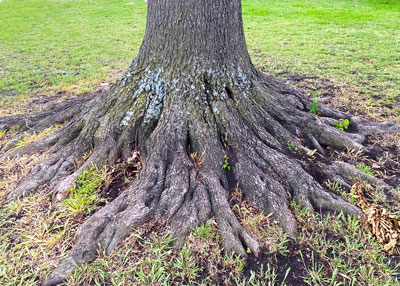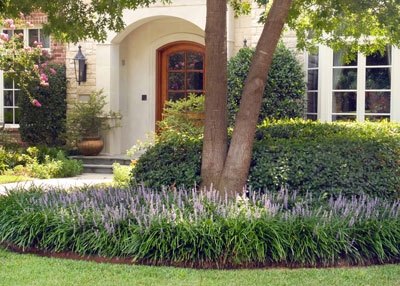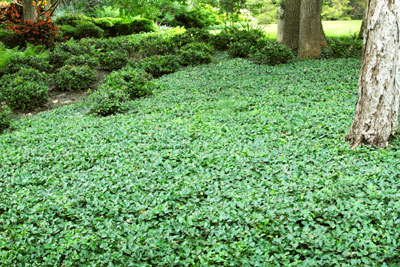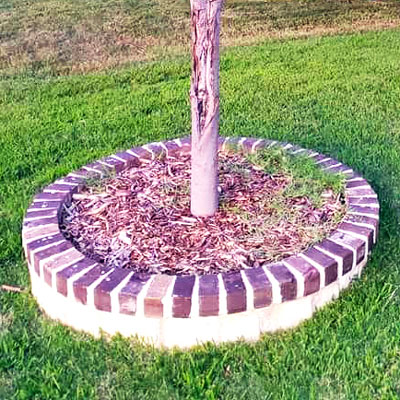Two Extremes of Root Flare
I present to you here the two extremes of root flares and we’ll talk about what you might do to live with each of them.
First, to identify, the “root flare” is where the trunk of the tree flares out to form the root system.

The root flare of the red oak…
That root flare is very obvious in the photo of the Shumard red oak, and actually, that tree is thriving at its great old age of probably 60-70 years. Its only problem is that it’s not terribly attractive that way.
Some people might think about hauling in topsoil to cover those roots in the mistaken idea that there’d been some kind of erosion over the years.
That’s not the case, however. It’s more likely that the tree was “planted high.” It was probably planted in a hole that was barely as deep as the soil ball of the tree. As the roots grew larger (and new roots formed), they became all the more obvious.
The best visual solution here would be to develop a large irregular groundcover bed to surround the trunk, preferably not featuring the trunk directly at its center. That would draw undue attention to it. I use the general outline of the drip line of the tree (where water falls during a gentle rain as if from an umbrella).
I use a supple garden hose on one of these warm summer days to lay out the bed in gently sweeping curves, and then I apply a glyphosate-only herbicide to kill existing grasses and weeds within the new bed before I prepare the soil.
As best I can I will work a couple of inches of compost and pine bark mulch into the top 2 inches of topsoil prior to planting my groundcover. I’m careful not to gouge any of the large roots in the process. When I get up near the dense mass of roots I do the best I can to plant my groundcover within them.
I want a tall or sprawling groundcover that could conceal the roots and any future swelling of growth they might make.


My choice would probably be green liriope, but I could also be talked into purple wintercreeper euonymous. The plants would need to be set randomly as space permitted. Liriope would grow tall enough to conceal the roots by its height. Wintercreeper would sprawl over them. The one advantage of liriope would be that it would have no runners to snag fallen leaves in autumn.
The course you should never take would be to add soil up and over these roots. Sure, you might be able to conceal them initially, but eventually they would grow up and out of that soil. Then you would want to add more soil. You would end up with a strange looking mound that would have archaeologists wondering what had been buried there.

The lack of root flare of this maple…
Ask any certified arborist to look at the second tree and he or she will instantly tell you that its root flare needs to be exposed. It’s too deep in the soil.
That usually happens when a tree is planted too deeply. It might be because the planting hole was deeper than it needed to be and the weight of the soil ball caused it to sink over time. But it can also be because someone has added fill soil around the tree. And it can be when a decorative ring and soil have been added around the tree’s trunk as you see in this photo.
The solution is to remove enough soil to expose the root flare. With larger trees, professionals use an air spade. Careful home gardeners can use a shovel and spray nozzle, but frankly, if the tree is important, you’re probably better off leaving the work to a pro.
In the case of this little maple, the sun scald damage it is facing by not having been protected by paper tree wrap for its first couple of years may kill it anyway. But to give it every chance that you can, the edging and fill soil should be taken away to get it back to the original grade.
